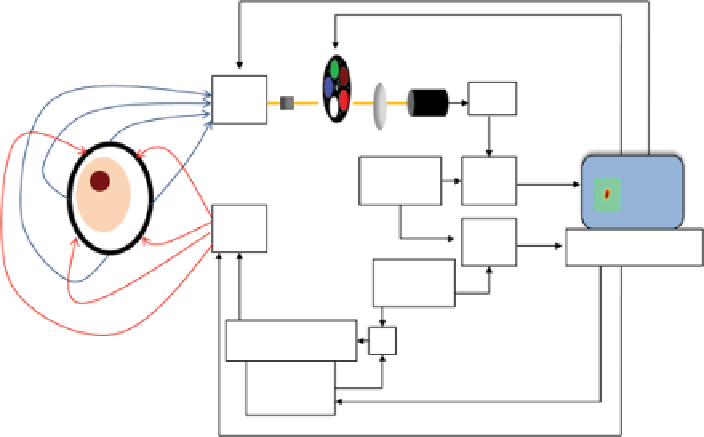Biomedical Engineering Reference
In-Depth Information
Emission
fibers
Fiber couple
with lens
Lens
PMT
Optical
switch
Pre-amp
Filter wheel
Oscillator
100 MHz
Mixer
Optical
switch
Mixer
Computer
SYNC
Oscillator
100.02 MHz
Excitation
fibers
Diode laser with
temperature controller
T
Laser power
supply and
cooler
FIgure 9.11
Schematic of a frequency-modulated system.
In practice, implementation of the FD is usually limited to one or a few modula-
tion frequencies. Therefore, the TD data can provide more information about the
media, since a short laser pulse contains a broader range of the modulation frequencies,
including the zero-frequency component. on the other hand, instrumentation for
time-resolved imaging is considerably more expensive, and data collection time is
longer relative to a FD system. Therefore, in applications that need very fast imaging,
the FD technique is more suitable.
9.5
ModelIng oF lIght propagatIon In tIssue
This section briefly discusses forward models of light propagation in tissue followed
by light propagation of fluorescence signal in high scattering media and different
simulation algorithms to implement these models.
9.5.1
Forward Model for light propagation in tissue
In highly scattering media, the light propagates in random directions. However, the
path of photon propagation from a source to a detector can be statistically modeled
with mathematical formulas. Photon transport in scattering media, like tissues, can
be modeled with the radiative transport equation (rTe)
ˆ
1 (,,)
∂
Lrst
∫∫
+∇
. (,,)
Lrsts
ˆ ˆ
=−
(
µµ
+
)
Lrst
(,,)
ˆ
+
µ
Lrs t f ss d Qrst
(, ,) (,
ˆ
′
ˆˆ
′
)
Ω +
′
(,
ˆ
,
)
s
a
s
c
∂
t
4
π
(9.8)

Search WWH ::

Custom Search